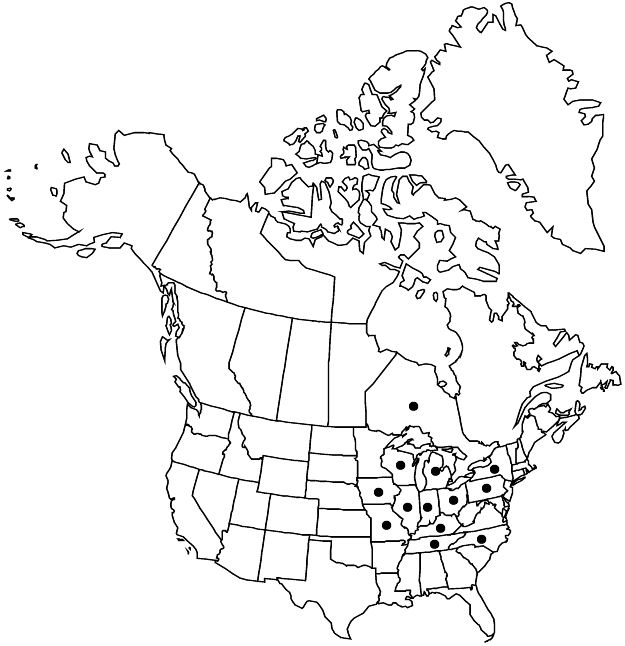Difference between revisions of "Crataegus pruinosa var. rugosa"
Publ. Bot. Milwaukee Public Mus. 3: 181. 1965.
FNA>Volume Importer |
FNA>Volume Importer |
||
| Line 14: | Line 14: | ||
|name=Crataegus rugosa | |name=Crataegus rugosa | ||
|authority=Ashe | |authority=Ashe | ||
| + | |rank=species | ||
|publication_title=J. Elisha Mitchell Sci. Soc. | |publication_title=J. Elisha Mitchell Sci. Soc. | ||
|publication_place=17: 5. 1900 | |publication_place=17: 5. 1900 | ||
| Line 20: | Line 21: | ||
|name=C. leiophylla | |name=C. leiophylla | ||
|authority=Sargent | |authority=Sargent | ||
| + | |rank=species | ||
}} {{Treatment/ID/Synonym | }} {{Treatment/ID/Synonym | ||
|name=C. mackenziei | |name=C. mackenziei | ||
|authority=Sargent ex Mackenzie | |authority=Sargent ex Mackenzie | ||
| + | |rank=species | ||
}} {{Treatment/ID/Synonym | }} {{Treatment/ID/Synonym | ||
|name=C. rubicundula | |name=C. rubicundula | ||
|authority=Sargent | |authority=Sargent | ||
| + | |rank=species | ||
}} {{Treatment/ID/Synonym | }} {{Treatment/ID/Synonym | ||
|name=C. seclusa | |name=C. seclusa | ||
|authority=Sargent | |authority=Sargent | ||
| + | |rank=species | ||
}} {{Treatment/ID/Synonym | }} {{Treatment/ID/Synonym | ||
|name=C. seducta | |name=C. seducta | ||
|authority=Sargent | |authority=Sargent | ||
| + | |rank=species | ||
}} | }} | ||
|hierarchy=Rosaceae;Rosaceae subfam. Amygdaloideae;Rosaceae tribe Gillenieae;Crataegus;Crataegus sect. Coccineae;Crataegus (sect. Coccineae) ser. Pruinosae;Crataegus pruinosa;Crataegus pruinosa var. rugosa | |hierarchy=Rosaceae;Rosaceae subfam. Amygdaloideae;Rosaceae tribe Gillenieae;Crataegus;Crataegus sect. Coccineae;Crataegus (sect. Coccineae) ser. Pruinosae;Crataegus pruinosa;Crataegus pruinosa var. rugosa | ||
| Line 48: | Line 54: | ||
|distribution=Ont.;Ill.;Ind.;Iowa;Ky.;Mich.;Mo.;N.Y.;N.C.;Ohio;Pa.;Tenn.;Wis. | |distribution=Ont.;Ill.;Ind.;Iowa;Ky.;Mich.;Mo.;N.Y.;N.C.;Ohio;Pa.;Tenn.;Wis. | ||
|discussion=<p>Variety rugosa is fairly common from Missouri to the mountains of North Carolina, then northward through the range of the species. The variety often has the most proportionately wide and most deeply incised leaves of the <i>Crataegus pruinosa</i> group. The leaves also characteristically have sharper and longer marginal teeth than other varieties. Extremes are <i>C. mackenziei</i> with acute lobes and C. seducta with rather obtuse lobes.</p><!-- | |discussion=<p>Variety rugosa is fairly common from Missouri to the mountains of North Carolina, then northward through the range of the species. The variety often has the most proportionately wide and most deeply incised leaves of the <i>Crataegus pruinosa</i> group. The leaves also characteristically have sharper and longer marginal teeth than other varieties. Extremes are <i>C. mackenziei</i> with acute lobes and C. seducta with rather obtuse lobes.</p><!-- | ||
| − | --><p>Unnamed plants of the southern Appalachian piedmont, very likely worthy of at least varietal rank, will key here and are differentiated from < | + | --><p>Unnamed plants of the southern Appalachian piedmont, very likely worthy of at least varietal rank, will key here and are differentiated from <i></i>var.<i> rugosa</i> as follows: leaf blade 4–6 cm (3–7 cm in <i></i>var.<i> rugosa</i>), laminas thin (finally chartaceous to somewhat coriaceous in <i></i>var.<i> rugosa</i>), basal corners of leaf rounded, bases often subcordate (not conspicuously rounded, bases rarely subcordate in <i></i>var.<i> rugosa</i>).</p> |
|tables= | |tables= | ||
|references= | |references= | ||
| Line 57: | Line 63: | ||
-->{{#Taxon: | -->{{#Taxon: | ||
name=Crataegus pruinosa var. rugosa | name=Crataegus pruinosa var. rugosa | ||
| − | |||
|authority=(Ashe) Kruschke | |authority=(Ashe) Kruschke | ||
|rank=variety | |rank=variety | ||
| Line 72: | Line 77: | ||
|publication year=1965 | |publication year=1965 | ||
|special status=Endemic | |special status=Endemic | ||
| − | |source xml=https://jpend@bitbucket.org/aafc-mbb/fna-data-curation.git/src/ | + | |source xml=https://jpend@bitbucket.org/aafc-mbb/fna-data-curation.git/src/f50eec43f223ca0e34566be0b046453a0960e173/coarse_grained_fna_xml/V9/V9_981.xml |
|subfamily=Rosaceae subfam. Amygdaloideae | |subfamily=Rosaceae subfam. Amygdaloideae | ||
|tribe=Rosaceae tribe Gillenieae | |tribe=Rosaceae tribe Gillenieae | ||
Revision as of 22:45, 16 December 2019
Shrubs or trees, 20–40(–70) dm, usually branched to base. Leaves: blade broadly ovate to deltate, 3–7 cm, length/width = 1–1.2, lobes 2–4 per side, distinct, lobe apex acute, base very broadly cuneate or truncate to weakly subcordate, adaxial surface glabrous, sometimes sparsely appressed-hairy along veins. Inflorescence branches glabrous. Flowers 15–22 mm diam.; stamens 20, anthers pale pink.
Phenology: Flowering Apr–May; fruiting Sep–Nov.
Habitat: Open scrub, light woodland shade
Elevation: 50–300 m
Distribution

Ont., Ill., Ind., Iowa, Ky., Mich., Mo., N.Y., N.C., Ohio, Pa., Tenn., Wis.
Discussion
Variety rugosa is fairly common from Missouri to the mountains of North Carolina, then northward through the range of the species. The variety often has the most proportionately wide and most deeply incised leaves of the Crataegus pruinosa group. The leaves also characteristically have sharper and longer marginal teeth than other varieties. Extremes are C. mackenziei with acute lobes and C. seducta with rather obtuse lobes.
Unnamed plants of the southern Appalachian piedmont, very likely worthy of at least varietal rank, will key here and are differentiated from var. rugosa as follows: leaf blade 4–6 cm (3–7 cm in var. rugosa), laminas thin (finally chartaceous to somewhat coriaceous in var. rugosa), basal corners of leaf rounded, bases often subcordate (not conspicuously rounded, bases rarely subcordate in var. rugosa).
Selected References
None.